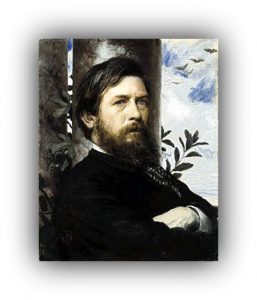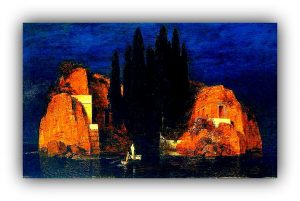 He was born on 1827 in Basel, attending the Dusseldorf Academy. At this time he painted scenes of the Swiss Alps. In 1848, his romantic introspection gave way to plein air, after he was influenced by Corot and Delacroix. But after the June revolutions, Arnold Böcklin returned to Basel, and he resumed painting gloomy mountain scenes. He resided in Florence (from 1874 until 1885), and this was his most active period, where he continued to explore the male-female antithesis. Böcklin exercised an influence on Surrealist painters Max Ernst, Dalí and de Chirico, and The Isle of the Dead, inspired several late-Romantic composers. In 1892, he returned to Italy, and died there on January day, in 1901.
He was born on 1827 in Basel, attending the Dusseldorf Academy. At this time he painted scenes of the Swiss Alps. In 1848, his romantic introspection gave way to plein air, after he was influenced by Corot and Delacroix. But after the June revolutions, Arnold Böcklin returned to Basel, and he resumed painting gloomy mountain scenes. He resided in Florence (from 1874 until 1885), and this was his most active period, where he continued to explore the male-female antithesis. Böcklin exercised an influence on Surrealist painters Max Ernst, Dalí and de Chirico, and The Isle of the Dead, inspired several late-Romantic composers. In 1892, he returned to Italy, and died there on January day, in 1901.
Everyone loves to travel, but not everyone loves to travel the same way. All you have to do is have the time of your life. Meeting Benches. The way to making the world a better place is easy.  Gallery 800, Metropolitan Museum of Art, the Met (1000 Fifth Avenue at 82nd Street, New York). http://www.metmuseum.org/ It is an oil on panel (size 73.7 × 121.9 cm), 2th version of the Isle of the Dead, painted by Arnold Bocklin on June 1880. What you can admire at the Met, it is the best-known painting of that Swiss Symbolist artist. Prints of this painting were very popular in central Europe in the early 20th century, and they could be found in every Berlin home. Between 1880 and 1886, Böcklin produced several different versions of the mysterious painting. All versions of that painting, depict a desolate and rocky islet seen across an expanse of dark water. A small rowboat is arriving at a water gate, and seawall on shore. An oarsman, maneuvers the boat. In the bow –facing the gate – is a standing figure clad entirely in white (just behind the figure, is a white object, commonly interpreted as a coffin).
Gallery 800, Metropolitan Museum of Art, the Met (1000 Fifth Avenue at 82nd Street, New York). http://www.metmuseum.org/ It is an oil on panel (size 73.7 × 121.9 cm), 2th version of the Isle of the Dead, painted by Arnold Bocklin on June 1880. What you can admire at the Met, it is the best-known painting of that Swiss Symbolist artist. Prints of this painting were very popular in central Europe in the early 20th century, and they could be found in every Berlin home. Between 1880 and 1886, Böcklin produced several different versions of the mysterious painting. All versions of that painting, depict a desolate and rocky islet seen across an expanse of dark water. A small rowboat is arriving at a water gate, and seawall on shore. An oarsman, maneuvers the boat. In the bow –facing the gate – is a standing figure clad entirely in white (just behind the figure, is a white object, commonly interpreted as a coffin).
 Meeting Benches World art in all forms
Meeting Benches World art in all forms







